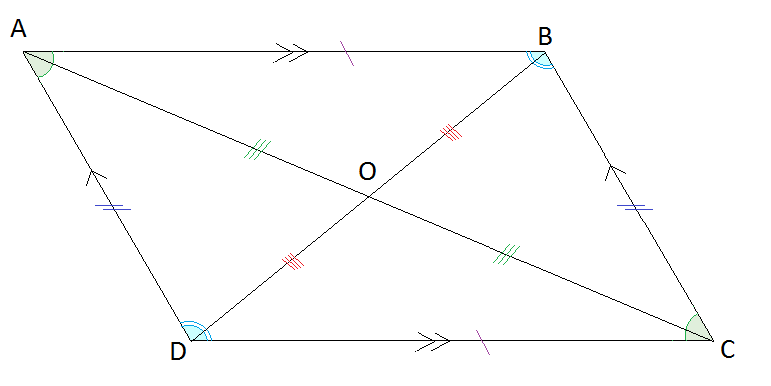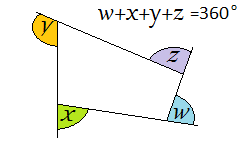
Angles and Lengths in Quadrilaterals Revision
All quadrilaterals
- Sum of exterior angles of a polygon is $360$360°
- Angle sum of a quadrilateral is $360$360°
ParallelogramOpposite angles in a parallelogram are equalOpposite sides in a parallelogram are parallel Opposite sides in a parallelogram are equal Diagonals of a parallelogram bisect each other $BO=DO$BO=DO and $AO=CO$AO=CO)
|
 |
 |
RectangleOpposite sides in a rectangle are equalOpposite sides in a rectangle are parallelAngles in a rectangle are equal to 90° Diagonals of a rectangle bisect each other ($BO=AO$BO=AO= $DO=CO$DO=CO ) Diagonals in a rectangle are equal ($BD=CA$BD=CA)
|
SquareAll sides of a square are equalAll angles in a square are equal to 90°Opposite sides in a square are parallel Diagonals of a square are perpendicular to each other (cross at 90°) Diagonals of a square bisect the angles at the vertices (makes them 45°) Diagonals of a square bisect each other ($BO=DO$BO=DO= $AO=CO$AO=CO ) Diagonals of a square are equal ($AC=BD$AC=BD)
|
 |
 |
RhombusOpposite angles of a rhombus are equalOpposite sides in a rhombus are parallelAll sides of a rhombus are equal Diagonals of a rhombus bisect each other at 90 degrees ($BO=DO$BO=DO and$AO=CO$AO=CO) Diagonals of a rhombus bisect corner angles. i.e. $\angle OAB=\angle OAD$∠OAB=∠OAD, $\angle OCD=\angle OCB$∠OCD=∠OCB, $\angle OBC=\angle OBA$∠OBC=∠OBA and $\angle ODC=\angle ODA$∠ODC=∠ODA Diagonals of a rhombus bisect each other ($BO=DO$BO=DO and $AO=CO$AO=CO)
|
Kite1 pair of opposite equal angles2 pairs of equal adjacent sidesThe longest diagonal of a kite bisects the angles through which it passes. i.e. $\angle BAO=\angle DAO$∠BAO=∠DAO and $\angle COD=\angle COB$∠COD=∠COB Diagonals of a kite are perpendicular to each other. The longest diagonal of a kite bisects the shorter diagonal ($BO=OD$BO=OD)
|
 |
 |
Trapezium>1 pair of opposite parallel sides
|
Isosceles TrapeziumDiagonals of an isosceles trapezium (trapezoid) are equal ($DB=AC$DB=AC)1 pair of opposite parallel sides
|
 |
Now that you know about 6 different types of quadrilaterals. Move the points (vertices) around and see how many different quadrilaterals you can find in the interactive below. (Watch this video if you would like to see this interactive in action -)
The following applet will allow you to manipulate different quadrilaterals using the blue points and see the properties appear with regards to the diagonals.
Worked Examples
Question 1
Question 2
Question 3
Find the value of all pronumerals in the figure, giving reasons.

Find $x$x
Find $y$y
Solving problems
When solving angle problems in geometry one of the most important components is the reasoning (or rules) you use to solve the problem. You will mostly be required in geometry problems to not only complete the mathematics associated with calculating angle or side lengths but also to state the reasons you have used. Read through each of these rules and see if you can describe why and draw a picture to represent it.
Properties of quadrilaterals
All Quadrilaterals
| Angle sum of an n-sided polygon is (n-2)[x]180 |  |
| Sum of exterior angles of a polygon is 360° |  |
| Angle sum of a quadrilateral is 360° |  |

Parallelogram
- Opposite sides in a parallelogram are parallel
- Opposite angles in a parallelogram are equal
- Opposite sides in a parallelogram are equal
- Diagonals of a parallelogram bisect each other

Rectangle
- Opposite sides in a rectangle are parallel
- Opposite sides in a rectangle are equal
- Diagonals of a rectangle bisect each other
- Diagonals in a rectangle are equal

Square
- All sides of a square are equal
- Opposite sides in a square are parallel
- Diagonals of a square are perpendicular to each other (cross at 90°)
- Diagonals of a square bisect the angles at the vertices (makes them 45°)
- Diagonals of a square bisect each other
- Diagonals of a square are equal
Rhombus

- Opposite angles of a rhombus are equal
- Opposite sides in a rhombus are parallel
- All sides of a rhombus are equal
- Diagonals of a rhombus bisect each other at 90 degrees
- Diagonals of a rhombus bisect corner angles
- Diagonals of a rhombus bisect each other

Trapezium
- An isosceles trapezium (trapezoid) has 2 pairs of adjacent angles equal
- A trapezium (trapezoid) has one pair of opposite sides parallel
- An isosceles trapezium (trapezoid) has one pair of opposites sides equal
- Diagonals of an isosceles trapezium (trapezoid) are equal
Kite

- A kite has 2 pairs of adjacent sides equal
- A kite has 1 pair of opposite angles equal
- The longest diagonal of a kite bisects the angles through which it passes
- Diagonals of a kite are perpendicular to each other
- The longest diagonal of a kite bisects the shorter diagonal
A summary of the geometrical properties of angles and angles on parallel lines can be found here.
A summary of the geometrical properties of triangles can be found here.
Worked Examples
QUESTION 1
QUESTION 2
QUESTION 3
Find the value of all pronumerals in the figure, giving reasons.

Find $x$x
Find $y$y